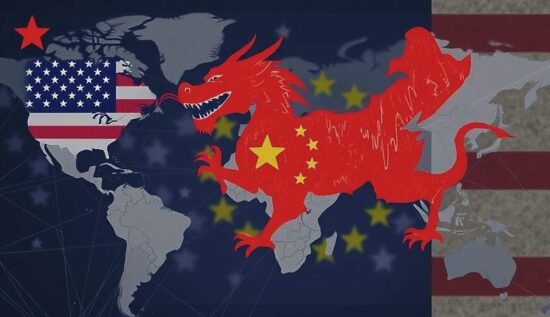US-China Trade Tensions Escalate as Tariffs Bite
The average tariff on Chinese goods imposed by US President Donald Trump is expected to reach as high as 70%. However, China is not planning to back down and is prepared to fight back. In response, Beijing has announced a retaliatory measure, imposing a 34% tariff on all US imports.
The confrontation between the two major economies is unlikely to be resolved through negotiations, unlike in the case of the 179 other states affected by Trump’s tariffs.
The high tariffs will inevitably lead to a decline in Chinese exports to the US, which stood at $440 billion last year. This means China will need to find new markets for its “surplus” products. Economists predict a surge in the export of cheaper Chinese goods to other countries, which could harm them and prompt them to retaliate against China.
After losing the US market, Chinese manufacturers will try to sell more of their products in the EU, according to Robin Winkler, chief economist at Deutsche Bank, speaking to the Financial Times.
Trump’s tariffs on Chinese goods will deal a double blow to the German industry, as products from China will flood into Germany, says Clemens Fuest, president of the ifo Institute. The German economy is expected to suffer losses of €200 billion over the next four years and the GDP is likely to decline by 1.5% by 2028, according to the institute’s experts in Cologne.
Natalia Miltschakowa, a leading analyst at Freedom Finance Global, notes that the estimated damage to China’s exports varies widely, ranging from $150 to $440 billion. In theory, Chinese exports to the US could decline by at least a third, or even 100%, although the latter is unlikely.
China has already weathered the first wave of the US trade war in 2018 and 2019. Despite US restrictions, Chinese exports to other countries, including those in Southeast Asia and the BRICS nations, increased. Beijing has also signed nine trade agreements, including a groundbreaking partnership with 15 Asian countries. In contrast, the US has not signed a single new trade agreement.
The previous tariffs have helped China to further develop its technological capabilities. Anna Fedjunina, a senior researcher at the Center for Structural Policy Research at the Moscow School of Economics, explains that the increase in tariffs during the first trade war encouraged Chinese companies to invest in research and development, leading to improved product quality.
China will likely seek new markets and technological development in response to the tariffs. Miltschakowa notes that it is no problem for China to find new markets, as it is a major global supplier or even a monopolist in certain products, such as drones, solar panels and rare earth metals. The country will likely focus on the BRICS nations, Asian countries, including Southeast Asia, Canada and the EU, which have a trade dispute with the US.
Eugene Baboschkin, head of the Corporate Development Department at Prime Brokerage Service, adds that for countries with less saturated consumer markets, such as those in South and Central America and Africa, a “golden era” of opportunities may arise, as the oversupply of consumer goods in the world’s largest economy will lead to significant price cuts on other markets.
China’s trade philosophy differs from that of the EU and the US, with a focus on utilizing and investing the profits from production, rather than maintaining high prices for certain brands and products.





